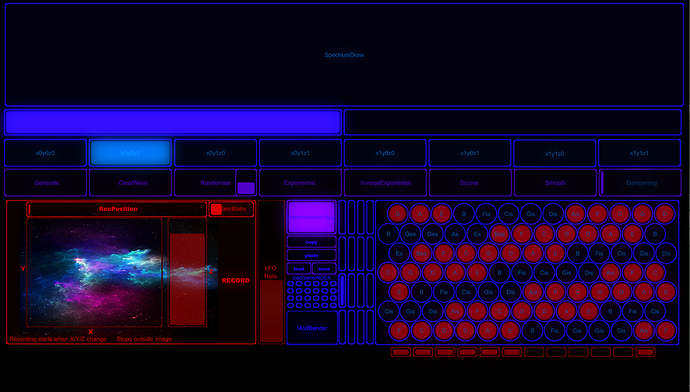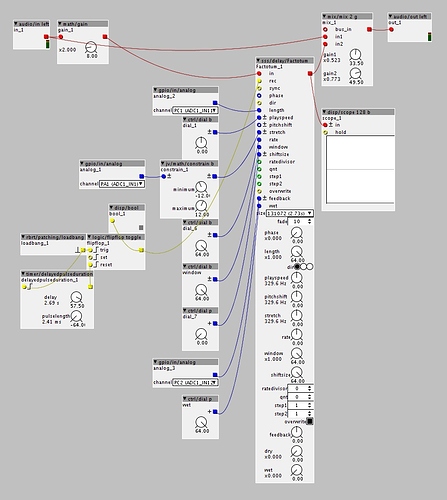NEW MODULES (ok, I uploaded some more in the meantime, but forgot to mention it, but there are some really useful ones now for when you use multiple axoloti's and want them to perfectly stay in sync ánd tune. I've made these module to create my 5-board axoloti setup)
MIDI
-"clkIN" and "clkOUT"
two modules that work together between different axoloti boards to share (next to the normal midi messages) actual play position (14bit counter position), main chord/scale/temperament(use 137temperament module) being used, a main randomisation trigger and 3 extra "main" triggers. The clock message can be switched between 2nds and 3rds and also this setting is shared over midi, so all other boards can immediately follow and stay in track. This clock runs at a division of the current play position, which should be seen as the "1/4 beat", so clock runs on either 1/8 or 1/12.
It also shares the main tempo setting in 28bits (using 4 midi messages), so all boards know exáctly how fast their lfo's and envelopes should be to stay in sync.
-"scaleReceiver" is a module that will receive the scale-notes that are send by the clkOUT module and can be controlled by a positive integer selecting an allowed note. For each of the 7 notes in the scale there is a toggle switch to allow which notes may be actually played from the scale (eg only 1-3-5 or 9-11-13 for a Cmajor or Dminor respectively)
-"chord builder" works in conjunction with the "scaleReceiver" module to control which chord is build from the scale using a chord root note, spreading of the chord and harmonicity (how many notes a chord is build up from). Though for this, you need to select midiCC for the toggle switches.
-"THRU" was an already existing module but I found out it didn't yet forward áll midi messages, but now it does (except sysex)
DIST
-"quadist" is a quad-mode distortion: sine-shaper, hard clip, tube and morphing stacked soft clipper
FILTER
-"champ" is a chamberlin filter, which, to me, sounds really nice. If I remember correctly, I also added a version with a compressor in the resonance feedback.
-"lowpress" is a filter brought about by a small experiment based on the normal 6dB lp filter. I added resonance and 2 controls to boost mid (pressence) and low.
-"neuronium" is based on the idea of the jomox neuronium. 6 neurons act and react on each other and produce all kinds of weird noises. Usable as standalone noise generator or as some kind of filter/distortion by feeding the first 3 neurons external inputs. Uses quite a lot of cpu, but might be useful somewhere. Just try out the factory edrum modules together with a sine for a bass and send them to the influence inputs, even simple sounds can go wacky.
AUDIO
-"StOutVolNorm" a stereo audio output module that keeps track of the peak output and has a normalisation function to set the volume control so it's output peaks maximally come to 32 to prevent clipping at the audio output (and to normalise patches with different modules/settings)
PATCH
-"sendPatch" and "patchloader". These module use incoming midiCC to select patches on other boards from a control-board.
The sendPatch has 3 inputs to set the minimum and maximum patch index that may be selected by next, previous or jump (jump is just next, but with min and max set to the same patch index).
These command are send using midiCC and changed into a patch-change command in the receiving board. As it responds to a midi-message, there is no accidental retriggering of patchchanges.
It also has a timer and pre&post triggers so you can trigger certain events before or after switching (eg. updating the loaded patch to the right scale or tempo currently used or to send an all-notes-off if needed).





 , but not for technical purposes
, but not for technical purposes
